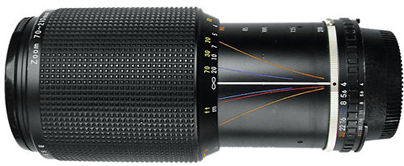A brief introduction on version History of Nikon's 70-210mm focal length zoom lenses:- Although generally we accept the fact back at the '70, it was Nikon Zoom-Nikkor 80-200mm f/4.5 was the first commercial produced zoom lens has helped greatly in successfully changing negative perception towards image quality of zoom lenses; but old time photographers may recall it was the Vivitar Series 1 70-210mm f/3.5 that has first popularized a "new" zoom range of 70-210mm. Nikon first zoom lens that aimed to challenge Vivitar was the Series E Zoom Nikkor 70-210mm f/4.0s in 1981 and that was the last of a zoom of 70-210mm produced by Nikon in MANUAL FOCUS spec. This specific zoom range was only re-appeared again during the mid of the 90 where Nikon released another manual focus Zoom Nikkor 70-210mm f/4.5~5.6s again for the budget, manual focus Nikon FM10 and Nikon FE10 models. The only thing you need to know relating to these zoom lenses is, most of the mentioned MF ones are single touch sliding zoom while the last of the bunch, MF Zoom Nikkor 70-210mm f/4.5~5.6s uses rotating design.
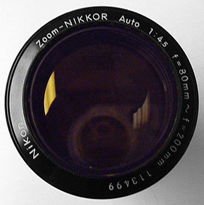 |
 |
|
Nikon AF Nikkor 70-210mm f/4.0s telephoto zoom lens
Introduced: February, 1986; Discontinued: 199+
The first autofocus Nikkor zoom lens with a telephoto zoom range in the early AF Nikkor lens group was not the popular 80-200mm as one would expect it to be. There were actually four other zoom lenses being introduced among the first batch of AF Nikkor lens group which covered from 28mm to 135mm; so until the arrival of the famed AF Zoom Nikkor 80-200mm f/2.8S ED which was introduced much later in 1988 in tandem with the first AF pro-calibre Nikon F4; the AF Nikkor 70-210mm f/4.0s was the only option for early Nikon photographers who may have bought the early series of Nikon autofocus SLRs such as Nikon F501 (N2020) or the F401/N4004 etc. All these early group of AF Nikkor zoom lenses possessed all the necessary encoders/levers at the lens mount and made them native Ai-S lenses; so, they can also be used with both AF and MF Nikon SLRs.
 |
A few noteworthy features found in this AF Nikkor tele-zoom was, it has a constant f/4.0 aperture that maintains throughout the entire zoom range from 70-210mm. Optically, the AF Zoom Nikkor 70-210mm f/4.0s shares identical optical formula with the previous Manual Focus 70-210mm Series E sliding zoom but the zooming control has been reverted to a rotating type. The zoom lens focuses down to merely 1.1m (3.7') with magnification ratio approaching to an impressive 1:4 and it has a 62mm filter attachment size. This AF Nikkor 70-210mm f/4.0s tele-zoom lens has quite an unconventional design, as the distance information window is being placed at the furthest end instead of placing it closer to photographer at the other end for easy references. Gone are the colored depth of field scales on the lens barrel as found on all those manual focus Nikkor zoom lenses. Neither there are any indicative DOF scales near the focusing index for quick visual reference. In terms of appearance, this AF Zoom 70-210mm zoom lens actually lacks "colors" in its presentation - except for the minimum aperture lock, f/32 and the exposed lens element - the entire lens is like a block of monochrome black. I am not sure if such decision was cost saving nor intentionally designed as to stealth itself for professional applications. |
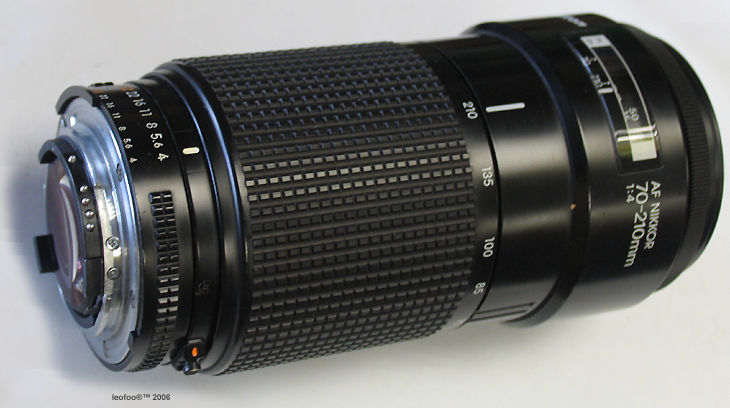 |
In one way, Nikon was very considerate enough to provide an XTRA wide zooming ring on this zoom lens; BUT can you spot the manual focusing ring ? it is the narrow 1/2 "strip" ridged plastic ring positions at the far end near the filter thread... |
Despite what I had highlighted earlier, I guess most people during the mid '80 were not particularly used to the sudden change in appearance of the "new" outfit used for those early series of AF Nikkor lenses. The decision of using an all harden polycarnonate lens barrel was another point that Nikon photographers were so resistance about with most of the early design where traditionally the rugged and sense of "long lasting" feel were heavily missed. However, personally I am quite okay as far as the rear section onwards - perhaps this could be even be made better than the many of today's autofocus Nikkor lenses in terms of an overall presentation. The rear lens mount was a metal piece, with an arrays of five electrical contacts as well as other necessary post, ridge and levers found in a typical Ai-S Nikkor lens. I guess except for the strange decision of the placement of the distance window to the furthest end, and despite it now uses a rotating zoom design, lens handling is still considered to be excellent The choice of a 2-rings zoom control in this version or the previous one-touch sliding zoom can be entirely a personal preference (I prefer the latter for it provides a responsive action during shooting). But Nikon has opt for separate control for zoom and focusing, it is just leaving to photographers to accept it rather than making a choice because there was none for you to decide on.
 |
Perspective compression, an unique optical behavior of a typical telephoto can be used to a wide varieties of subject; such as these power grids along the highway to Kuala Lumpur International airport ..... |
The filter ring of this AF Nikkor 70-210mm f/4.0s zoom lens actually rotates when focusing, where you may take note when using it with some special filters and/or accessories. However, presumably, as Actually, it can be quite an odd decision to use special filters such as polarizer with a tele-zoom as the effect is not as prominent as compare to wideangles; This early AF version of the Nikkor tele-zoom only behaves itself barely as an autofocus lens and has an Ai-S configuration. It is not 3D matrix meter ready zoom lens as it was a products of the mid '80 and don't expect it to deliver full compatibility with current prevailing Nikon SLR camera models (just imagine or relate how a PC works during those days should make you more forgiving). I am not convinced it will focus faster even when using it with a Nikon F5 or a DSLRs such as Nikon D2X combination but it will deliver bare basic operation as well as exposure measurement system a generation earlier of the 3D Matrix Metering offers. But most of all, I think it may affect camera's functions more than anything from now (as at 2007). Take the example of the Nikon F5: It says by mounting a NON-D Nikkor for the FOCUSING METHOD:- AF, Electronic viewfinder and Manual Focusing possible.."; METERING "..Non-D type AF Nikkor lenses, Matrix meter instead of Color Matrix, Center-Weighted Average Metering: distribution of sensor output can be changed; Spot meter varies on "certain condition"..."; for EXPOSURE CONTROL MODES: it says "... all modes possible, aperture can also be selected via Sub-command dial .. " - so, technically, an old first generation AF Nikkor zoom like the AF Zoom Nikkor 70-210mm f/4.0s seemingly works just fine. Perhaps, some higher end Nikon SLRs with improved AF algorithms may improve the AF performance.
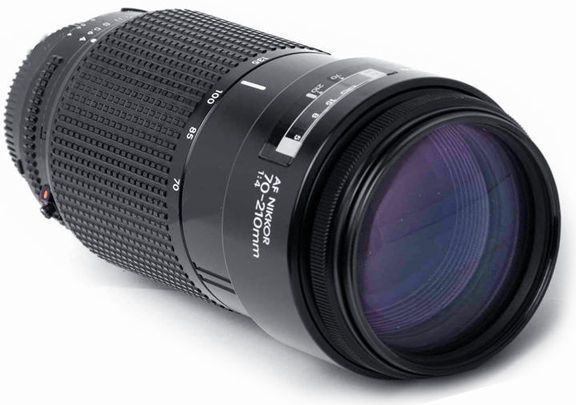 |
|
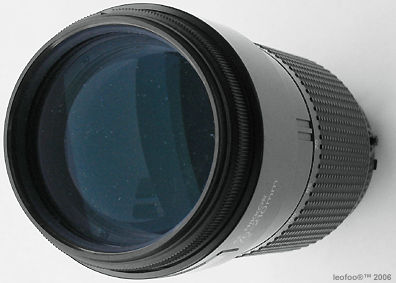 |
I guess many people often like to use the high standard created in all those earlier generation of MANUAL FOCUS Nikkor lenses to compare the new autofocus Nikkor. I always thought the Series E zoom 70-210mm f/4.0S was a good zoom, only let down by some cheap decision on critical built areas. The AF Zoom Nikkor 70-210mm f/4.0S was like an exact replica of the Series E tele-zoom. It may not please a few critics but optically it is a true performer but sadly both the Series E zoom and this early AF zoom were considered as a failure commercially and didn't get the recognition they deserved. This lovely AF Zoom Nikkor 70-210mm f/4s was phased out towards the first quarter of the '90. A re-introduction of a constant aperture AF Nikkor 70-210mm f/4.0 has NEVER BEEN RE-INTRODUCED since. |
Measuring approx. 6.1" (148mm) excluding lens extension during zooming and/or focusing. The entire lens is separated into 4 sections for lens control:- a metal filter attachment ring/manual focusing ring at the further end, distance information window; an extra-wide zoom collar ring, and the aperture control (with ADR (Aperture direct readout Scales ring) at the rear end. The zoom settings are marked from 75mm (green) to 85mm, 100mm, 135mm and 210mm respectively. It has two infra compensation marks of 70mm and 210mm.
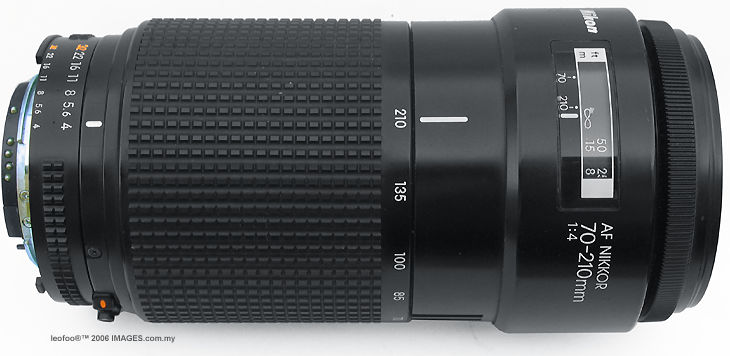 |
The minimum aperture lock of this early AF zoom uses a twisted knob design as opposed to modern design in a tiny slide switch type. It has an orange mark. |
Traditionally, telephoto zoom with 70-210/80-200mm can be used for a wide varieties of application. It should compliment if your other investment is a wideangle zoom lens (or a Nikkor wideangle) as it is versatile with a zoom to alter foal length for some very frequently used telephoto focal lengths, it provides a the reach where wideangle zoom may show some handicaps in this area. You can use it freely for situations such as candid, portraiture, scenic nature, close-ups, moderately accessible sports, travel etc. The maximum aperture of f/4.0 may be adequate for most possible usage for all these on-location shootings. If you wish, you can combine it with a faster film type and/or adjust the AUTO ASA in your digital SLR to improve its functionality to deal with lack of lens speed. With a DX format Digital SLR, it interprets itself as an approx. 100-315mm telephoto zoom lens. If that is not god enough, you may couple the lens with Nikon Teleconverter(s) to multiply the primary focal lengths (note: the closest focusing distance will not be affected even if it amplifies). The compatible TC units are TC-201S; TC-14AS but usage of the AF TC-16AS is not permitted Naturally, the use of TC only limits its function back to manual focus only.
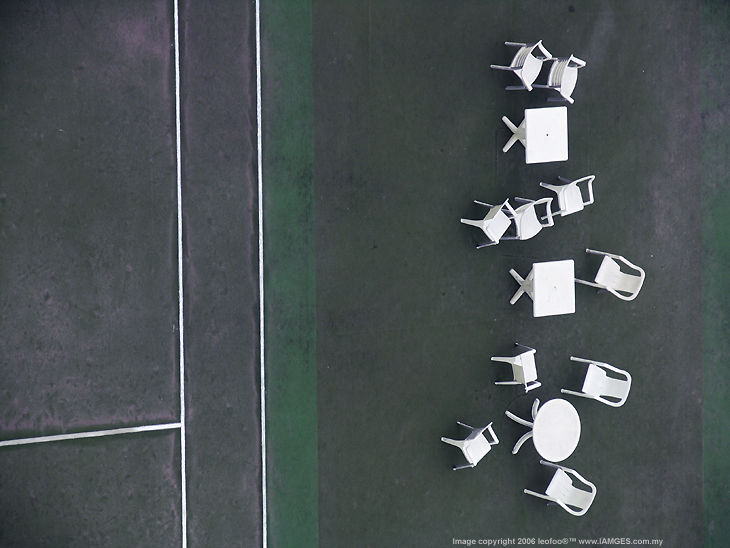 |
A telephoto range of a zoom is also useful for isolating a small segment of a common scene, a view from the room of the service apartment on an old, unmaintained tennis court at Bangkok ..... |
![]()
Technical
Specification
for Nikon AF Zoom Nikkor 70-210mm
f/4.0S Telephoto zoom lens:-
Type of lense: Autofocus Nikkor zoom lens with built-in CPU and a metal rear
Nikon bayonet mount
Focal length: 70mm to 210mm; Maximum aperture: f/4.0; Minimum Aperture:
f/32; 105-315mm for APS DX format DSLR.
Lens construction: 13
elements in 9 groups
Picture angle: 34°
20' ~ 11° 50'
Focal
length scale: 70mm
(marked in green), 85mm, 100mm, 135mm and 210mm rotating angle on zoom ring
Diaphragm: Fully automatic,
Focus
control: Autofocus with zoom control; Manual via manual focusing ring
Zoom control: Via one-touch push and pull zoom ring
Distance scale: Graduated in meters and feet/inches from 1.1m (3.7') to infinity
(OO); MACRO: Closest distance 1.1m for all zoom range in manual focus
Distance information: Output into camera body with CPU interface system IS NOT POSSIBLE with this lens; Option
for manual focus provided
Aperture scale: f/4.0, f/5.6, f/8, f/11, f/16, f/22 and f/32 on both standard and aperture-direct-readout scales |
Caompatible Tele-Converters: - TC-201S; TC-14AS (note: MANUAL focus only and when using aperture smaller than f/11 with high shutter speed, uneven exposure may occur.* Other information: A. Be careful not to soil or damage the CPU contacts. Do not attach the following accessories to the lens, as they might damage the lens' CPU contacts: Auto Extension Ring PK-1, Auto Extension Ring PK-11*, K1 Ring, Auto Ring BR-4**. Nikon doesn't advise the use of TC-16AS with this lens.
Other accessories may not be suitable for use with certain cameras. This lens cannot be used with AF Finder DX-1 attached to the Nikon F3AF camera. * Use PK-11A instead. **Use BR-6 instead; B. Startup Serial Number for the Nikon AF Zoom Nikkor 70-210mmmm f/4.0S tele-zoom lens may have been began from: AF 70-210/4 200001 < 264236 - 419896 > Sep86 - Sep87 Reference: Roland Vink's lens data sheet.
| NEXT | 1/3 AF Nikkor Zoom 70-210mm f/4~5.6S
telephoto zoom lens with a new dressing and lens control
AF
Zoom-Nikkor 70-210mm f/4.0s
| AF
Zoom-Nikkor 70-210mm f/4~5.6S
| AF
Zoom Nikkor 70-210mm f/4~5.6D
RELATIVE:- Nikon Series E Manual Focus Zoom
70-210mm f/4.0S
| Manual
Focus Zoom Nikkor 70-210mm f/4.5~5.6S
| AF
Zoom Nikkor 75-300mm f/4.5~5.6S
/ AF
Zoom Nikkor 70-300mm f/4~5.6D ED
/ AF
Zoom Nikkor 70-300mm f/4~5.6G
/ AF
Zoom Nikkor 75-240mm f/4.5~5.6D
/ AFS
VR Zoom Nikkor 70-300mm f/4~5.6G IF-ED
EXTERNAL LINKS: Good review provided by KenRockwell, Australia
on AF70/210f4s
and AF f4~5.6D;
Another good review with technical analysis on AFD- version by Yurly Vilin for Photozone as well as another by Ulrich
Grothaus on the older 70-210mm f/4s;
Nikonian site on some recommendations; Photonet discussion on this AF Nikkor tele-zoom
ONE/
TWO
Main Index Page - Autofocus Nikkor lenses
| Message Board |
for your
Nikkor
Optics
in a shared environment
| Message Board | Specifically for Dispose or Looking for new/used Nikon/Nikkor photographic equipment
| Nippon Kogaku Rangefinder Resources | Nikon F | Nikon F2 | Nikon F3 | Nikon F4 | Nikon F5 | Nikon F6 | Nikkormat / Nikomat | Nikon FM Series | Nikon FE/ FA | Nikon EM/FG/FG20 | Nikon Digital SLRs | Nikon - Other models |
Nikon MF RF-Nikkor lenses for Rangefinder
cameras:-
Main Index Page
Nikon
Auto Focus Nikkor lenses:- Main Index
Page
Nikon
Manual
Focus
Nikkor lenses:-
Fisheye-Nikkor Lenses - Circular |
Full Frame |
Ultrawides Lenses - 13mm15mm18mm20mm |
Wideangle Lenses - 24mm28mm35mm |
Standard Lenses - 45mm 50mm 58mm | Telephoto Lenses
- 85mm105mm135mm180mm & 200mm |
Super-Telephoto Lenses - 300mm 400mm 500mm 600mm 800mm 1200mm |
 |
Special Application
lenses: Micro-Nikkor Lenses - 50mm~55mm -60mm 85mm -105mm 200mm Micro-Zoom 70-180mm Perspective Control (PC) - 28mm 35mm PC-Micro 85mm Dedicated Lenses for Nikon F3AF: AF 80mm f/2.8 | AF 200mm f/3.5 EDIF Depth of Field Control (DC): 105mm 135mm Medical Nikkor: 120mm 200mm Reflex-Nikkor Lenses - 500mm 1000mm 2000mm Others: Noct Nikkor | OP-Nikkor | UV Nikkor 55mm 105mm | Focusing Units | Bellows-Nikkor 105mm 135mm Nikon Series E Lenses: 28mm35mm50mm100mm135mm | E-Series Zoom lenses: 36~72mm75~150mm70~210mm |
MF Zoom-Nikkor Lenses: 25~50mm | 28~45mm | 28~50mm | 28~85mm | 35~70mm | 36~72mm E | 35~85mm | 35~105mm | 35~135mm | 35~200mm | 43~86mm | 50~135mm | 50~300mm | 70~210mm E | 75~150mm E | 80~200mm | 85~250mm | 100~300mm | 180~600mm | 200~400mm | 200~600mm | 360~1200mm | 1200~1700mm
Tele-Converters: TC-1 | TC-2 | TC-200 | TC-201 | TC-300 | TC-301 | TC-14 | TC-14A | TC-14B | TC-14C | TC-14E | TC-16 | TC-16A | TC-20E
Recommended links to understand more technical details
related to the Nikkor F-mount and production Serial Number:
http://rick_oleson.tripod.com/index-153.html by: my
friend, Rick Oleson
http://www.zi.ku.dk/personal/lhhansen/photo/fmount.htm by: Hansen,
Lars Holst
http://www.mir.com.my/rb/photography/hardwares/nikonfmount/lens2.htm
http://www.photosynthesis.co.nz/nikon/serialno.html
Recommended Reading Reference on Nikon cameras and Nikkor lenses | about this photographic web site
| | Back | Main Index Page of Nikkor Resources | Back | Main Index Page of Pictorial History of Nikon SLRs |
| Home - Photography in Malaysia |
![]()
Credit: To all the good
people who has contributed their own experience, resources or those who are kind
enough granting us permission to use their images appeared in this site Note:certain
content and images appeared in this site were either scanned from official marketing
leaflets, brochures, sales manuals or publications published by Nikon over the years
and/or contribution from surfers who claimed originality of their work for educational
purposes. The creator of the site will not be responsible for may discrepancies arise
from such dispute except rectifying them after verification."Nikon", "Nikkormat", "Nippon Kokagu
KK"
& "Nikkor" are registered
tradename of Nikon Corporation Inc., Japan. Site made with an Apple IMac.
